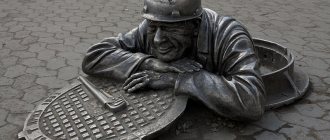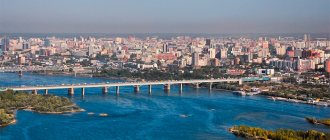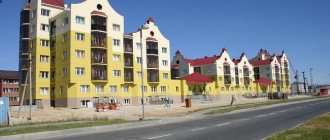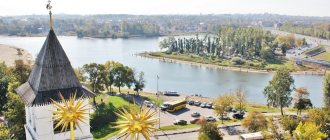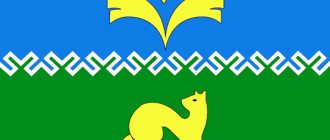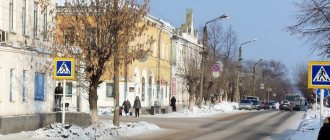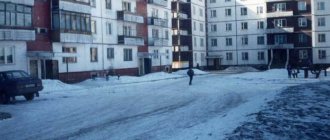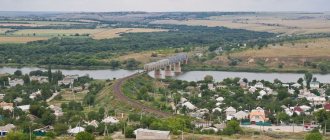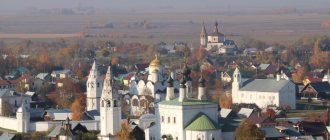What holiday is it today?
January 22, 2022, Saturday
Today are holidays, events: Day of Unification of Ukraine Tomorrow: Premiere of the opera “Eugene Onegin” at the Bolshoi Theater
Today is the Orthodox holiday: Martyr Polyeuctus. St. Philip, Metropolitan of Moscow and All Russia, wonderworker... Tomorrow: St. Gregory, Bishop of Nyssa. Venerable Markian the presbyter. Venerable Dometian, Bishop of Melitino. St. Paul of Komel, wonderworker, student of St. Sergius of Radonezh. Saint Theophan, the Recluse of Vyshensky...
Today is a national holiday: St. Philip's Day... Tomorrow: Gregory - Summer Guide...
Medium-sized cities 20-100 thousand people
Khanty-Mansiysk
Population 96,936 people (2016). The capital of the Khanty-Mansiysk Autonomous Okrug.
Kogalym
Population 63,334 people (2016).
Nyagan
Population 57,120 people (2016).
Megion
Population 48,818 people (2016).
Langepas
Population 43,377 people (2016).
Raduzhny (Khanty-Mansiysk Autonomous Okrug)
Population 42,963 people (2016).
Pyt-Yakh
Population 40,910 people (2016).
Urai
Population 40,477 people (2016).
Lyantor
Population 40,024 people (2016).
Yugorsk
Population 36,734 people (2016).
Sovetsky (city)
Population 29,179 people (2016).
Beloyarsky
Population 20,282 people (2016).
Seasons
Seasons, four periods of the year (spring, summer, autumn and winter) characterized by certain average temperatures. The period during which the Sun passes through one of these sectors is called the season. Spring in the Northern Hemisphere and autumn in the Southern Hemisphere begin when the Sun passes through the initial circle of declination and its right ascension is 0° (vernal equinox). Summer in the Northern Hemisphere and winter in the Southern Hemisphere occur when the sun's right ascension is 90° (summer solstice). Autumn in the Northern Hemisphere and spring in the Southern Hemisphere begin when the sun's right ascension is 180° (autumnal equinox). The beginning of winter in the Northern Hemisphere and summer in the Southern Hemisphere is considered to be the winter solstice, when the direct ascension of the Sun is 270°... Next: Seasons. Russian folk calendar. Monthly words...
Content
- 1 Large cities 250-500 thousand people 1.1 Surgut
- 1.2 Nizhnevartovsk
- 2.1 Nefteyugansk
- 3.1 Khanty-Mansiysk
- 4.1 Wiggle
Folk calendar about every day
Every day one season always replaces another and this determines a person’s way of life. In connection with this, a folk calendar was formed in which there were practically no nameless, unmarked days. Every day was special, had its own purpose. All this was determined by climate conditions and astrological phenomena.
A calendar is a system for counting periods of time. The first calendars arose a long time ago, in ancient times, because there was a need to measure time. The word calendar comes from the Latin words caleo - to proclaim and calendarium - debt book. This is due to the fact that in Ancient Rome the beginning of each month was especially proclaimed, and because it was customary to pay debts on the first day of the month. Different peoples counted time differently. Some calendars are based on the changing phases of the moon - lunar calendars; in others - the change of seasons - sunny; in others, the length of the year was coordinated with the change of seasons, and the counting of months was associated with the phases of the Moon. Such calendars are called lunisolar.
In Rus', the calendar was called a monthly calendar. Every day, the month book covered the entire year of peasant life, “describing” day by day, month after month, where each day had its own holidays or weekdays, customs and superstitions, traditions and rituals, natural signs and phenomena. The cyclical nature of the calendar is reminiscent of human life, where spring is youth, summer is heyday, autumn is the time of harvesting fruits (it’s good if there are some, otherwise you can live your life without collecting fruits), winter is the time of wisdom and peace. This cyclicality and rhythm determined the way of life of the farmer. The folk calendar was an agricultural calendar, which was reflected in the names of the months, folk signs, rituals and customs. Even the determination of the timing and duration of the seasons is associated with real climatic conditions. Hence the discrepancy between the names of the months in different areas... Next: Folk calendar...
Pokachi and Langepas are among the top 10 youngest cities in the country
Do you know how many cities there are in Russia? According to the latest census - 1,113. An interesting fact is that our Pokachi and Langepas are also in the top 10 youngest cities in the country, although in fact there are much more young cities in the district.
The beginning of the history of the city of Pokachi, like many cities in Western Siberia, was the confirmation of industrial reserves of black gold. The first gush of oil was obtained in November 1970, the culprit of this event was the 21st exploration well. Pokachi grew from a rotational camp of the same name among swamps and taiga in the basin of the Agan and Vat-Yogan rivers. It was built and developed thanks to the courage and enthusiasm of people of various professions and nationalities. In 1992 it was given city status. By the way, its name is a tribute to the Pokachev family, on whose lands oil was discovered. Langepas, which received city status in 1985, also entered the top ten youngest cities in Russia. The name of the city means “squirrel country,” so its symbol is a fluffy and cheerful animal that adorns the flag and coat of arms. Langepas is the base city of the oil industry, it was he who gave the company the first letter of its name. The village of Langepas was built by builders from Belarus, so the first cinema in the village was called “Belarus”. Langepas received the status of a city of district subordination on August 15, 1985; this year it turned 32 years old. Today more than 40 thousand people live in Langepas. A little more - about 50 thousand people - live in Raduzhny, whose appearance on the map is associated with the development of the Varieganskoye field. In 1973, on the site of the future city, a landing party of workers from SMU No. 9 of the Nizhnevartovskneftestroy trust landed, a rotation camp appeared, which grew every year: builders and oil workers started families and gave birth to children. When the village was registered in 1978, the residents thought for a long time: what to call it? They even announced a competition, and offers poured in: Sosnovy Bor, Yagelny, Neftegrad. Eyewitnesses say that the proposal of the secretary of the district committee of the CPSU Sergei Shekhirev was recognized as the best: this is how the village received the name Raduzhny, and on August 15, 1985 it became a city. Nefteyugansk, which celebrates its 50th anniversary this year, looks like the older brother among these young cities. The city owes its birth to the richest oil reserves of the unique Ust-Balyk field, discovered in 1961. Construction of the city began with the landing of geological explorers on the coast of the Yuganskaya Ob River. The status of a city was assigned to the oil exploration workers' settlement on October 16, 1967.
However, 50 years is still a very young age for a city, especially in the history of centuries-old Ugra, which dates back to 1193.
We know how you can best receive news. Our official accounts on social networks: VKontakte, Facebook, Odnoklassniki, Twitter, Instagram, Yandex.Zen, Viber.
Fishing calendar for every day
The fishing calendar should not be taken as an absolutely indisputable truth. Fish biting is greatly influenced by a whole range of natural factors, as well as the influence on the nature of man himself. You must not forget that the fish’s bite depends and is determined not only by the calendar dates and biological cycles of their life, reflected in the calendar, but also, no less, by the state of their habitat; the bite also depends on weather conditions: air and water temperatures, cloudiness, wind direction and strength, etc... Next: Fishing calendar...
Orthodox calendar about every day
Orthodox calendar: Orthodox, Church and Christian holidays.
The church year is an alternation of weekdays and holidays. On weekdays, a person is called to work “by the sweat of his brow to earn his bread.” Holidays are given in order to feel liberation, to rise above the bustle and routine of the world, to feel involved in the highest of worlds, “where there are no illnesses, sorrows and sighs, but endless life.” Since ancient times, holiday cycles have been associated with the seasons. The pagans associated them with the worship of the forces of nature, the cult of which in the Old Testament was replaced by gratitude to the Creator for the universe. And although the connection between holidays and the seasons has not completely lost its power, since God is present in everything, in the plant and animal world, in human works, it nevertheless faded into the background, giving way to a spiritual foundation built on the Sacred Scriptures. The history of Orthodox holidays dates back to the times of the Old Testament. Each of the Orthodox holidays is dedicated to the remembrance of the most important events in the life of Jesus Christ and the Mother of God, as well as the memory of saints... Next: Orthodox calendar...
Russian folk calendar for every day
The word “sign” comes from the word “notice”, i.e. observe. As a result of observing what happens around a person every day, he accumulates life experience. This knowledge was passed down from generation to generation, carefully preserved and people trusted it as a sacred book. Many signs have come to us from the depths of centuries without losing their knowledge. Each of us is free to choose: to dismiss all this as an absurd superstition or to take a closer look at the signs and take the centuries-old experience of generations more seriously. Most of us, when taking exams, ask them to scold them, boasting about some kind of good fortune or luck, spit so as not to jinx them or knock on wood, take a detour if a black cat crossed the road, are afraid of the number 13 and much more. And who among us does not have lucky things, numbers? Who has never resorted to the help of fate at least once in their life, who has not believed in secrets? It’s as if everything connected with signs is hidden somewhere deep in our subconscious. Often we remember them mechanically, unconsciously, or just as a joke. But, undoubtedly, the signs contain a lot of accurate knowledge and practical wisdom of our ancestors. They cover all the characteristic, often difficult to perceive, natural phenomena. Signs have preserved a lot of what was in old folk holidays and customs; they help predict the weather, grow crops... Next: Folk signs...
see also
- Khanty-Mansiysk Autonomous Okrug
- Tyumen region
- Cities of Russia
| [ + ] Cities by regions of Russia | |
| Cities of the North-West (NWFD) | St. Petersburg (and its cities) • Leningrad region (historical Staraya Ladoga) • Arkhangelsk region • Vologda region • Kaliningrad region • Karelia • Komi • Murmansk region • Nenets Autonomous Okrug • Pskov region |
| Cities of the Volga region (Volga Federal District) | Bashkortostan • Volgograd region • Kalmykia • Kirov region • Mari El • Mordovia • Nizhny Novgorod region • Orenburg region • Penza region • Perm region • Samara region • Saratov region • Tatarstan • Udmurtia • Ulyanovsk region • Chuvashia |
| Cities of Southern Russia (SFD) | Sevastopol (including Inkerman) • Republic of Crimea • Adygea • Astrakhan region • Krasnodar region • Rostov region |
| Cities of the North Caucasus (NCFD) | Dagestan • Ingushetia • Kabardino-Balkaria • Karachay-Cherkessia • North Ossetia - Alania • Stavropol Territory • Chechen Republic |
| Cities of the Urals (Ural Federal District) | Kurgan region • Sverdlovsk region • Tyumen region • Khanty-Mansi Autonomous Okrug - Yugra • Chelyabinsk region • Yamalo-Nenets Autonomous Okrug |
| Cities of Siberia (Siberian Federal District) | Altai Republic • Altai Territory • Irkutsk Region • Kemerovo Region • Krasnoyarsk Region • Novgorod Region • Novosibirsk Region • Omsk Region • Tomsk Region • Tyva • Khakassia |
| Cities of the Far East (FEFD) | Amur Region • Buryatia • Jewish Autonomous Region • Trans-Baikal Territory • Kamchatka Territory • Magadan Region • Primorsky Territory • Sakha (Yakutia) • Sakhalin Region • Khabarovsk Territory • Chukotka Autonomous Region |
| see also | Cities of the DPR, LPR, Transnistria, South Ossetia • Regions of Russia • Cities of Russia |
Holiday calendar, dates and events of the year
All state and professional holidays in Russia, including significant World and International holidays, and other equally interesting holidays and events about every day.
The holiday has always kept pace with the history of mankind. Social time can be divided into three types: everyday life (weekdays), weekends and holidays. Everyday life is a series of practices repeated day after day and every day (work). Weekends are regular breaks from the rush of everyday life. It is believed that on weekends a person should restore his strength after working days. Day off, non-working day. A holiday is a day of celebration established in honor or in memory of someone or something. A day or series of days celebrated by the church in memory of a religious event or saint... Next: Calendar...
Prayer book, Orthodox prayers for every day
Prayer is the most powerful means for healing all illnesses - both physical and mental. Prayers can be laudatory or grateful, petitionary and repentant. If we have offended God, sinned, we must ask Him for forgiveness, that is, repent. Such prayers are called repentant prayers. If everything is fine with us, if we and our loved ones are healthy and prosperous, if we have a place to live, something to wear, something to eat, we must glorify and thank God for this. Such prayers are called praise or thanksgiving. If some misfortune, illness, trouble or need happens, you need to ask God for help. Such prayers are called petitionary... Next: Orthodox prayers...
Zodiac, astrological, eastern calendar. Zodiac signs
In ancient times, to establish the calendar, priests used knowledge of the positions of all the planets. Before the reform of Peter 1, the New Year was celebrated on the Day of the Autumn Equinox. On this day, according to ancient legend, the most peaceful treaty was concluded between the Great Race (ancient Slavs) and the Great Dragon (ancient Chinese) and it was approximately 7518 years ago... For the ancient Slavs, the calendar month corresponded to the lunar cycle from new moon to new moon, taking into account such Thus, the relationship of the entire annual cycle with astronomical and natural phenomena. There was no coherent calendar system. The main natural phenomena are still considered to this day to be the days of the solar equinox and solstice - the Slavic holidays Maslenitsa, Kupala, Ovsen and Kolyada. But during the time of Peter 1, all ancient Slavic calendars were abolished and a new Western European calendar from the Nativity of Christ (Julian calendar) was introduced, while the beginning of the calendar was moved to January 1. The Julian calendar (old style) did not take leap days into account and accumulated one extra day every 128 years. After the October Revolution in 1918, the Gregorian calendar (new style) was introduced in Russia, according to which an amendment of 13 days was introduced. The calendar of the ancient Slavs was based on two planets: the Sun and the Moon. And now they don’t use anything at all. The calendar has become static. There is no such thing as the calendar, it turns out, resting on some planet. Nobody even knows about it. There are just some standard numbers, there are months and holidays. The calendar is based on the Sun and Moon. Why is this so? Because these two luminaries influence the Earth. The Earth revolves around the Sun, and the Moon revolves around the Earth. And these two luminaries create the atmosphere on the planet. From here the calendar is built... Next: Astrological calendar...
General information about the Khanty-Mansiysk Autonomous Okrug
Distinctive features. Mecca for those who love black money. A place from which more than 50% of all Russian oil is pumped out annually, most of which is sold to the West, making the oligarchs richer every day. The Khanty-Mansiysk Autonomous Okrug - Yugra ranks first in Russia in oil production and second in gas production. The main large cities are concentrated around oil fields. Their population is constantly growing - many believe that this is a kind of “American Dream”. True, in the middle of the taiga expanses of Siberia.
Black gold. It paints many hearts exactly this color
Despite the abundance of industrial cities, the Khanty-Mansi Autonomous Okrug - Ugra still has a small number of indigenous inhabitants: Khanty, Mansi, Nenets. This is a people with a rich history, centuries-old traditions, and a unique culture. Their main occupations are hunting, fishing, fur trading, and animal husbandry.
Mansi and the little ones Mansyata. Photo by dreamer (https://fotki.yandex.ru/users/valeriy-dreamer/)
Tourism of all types is quite seriously developed in the Khanty-Mansiysk Autonomous Okrug. This is not surprising, because the hills and elevations offer endless opportunities for alpine skiing, snowboarding, and kiting. And lovers of sports and ecological tourism will be able to enjoy exploring numerous natural parks and reserves. And even visit two state reserves.
By the way, about the environment. But here everything is bad. Emissions from the combustion of oil gas, petroleum products, pollution from exhaust gases in large cities - all this causes irreparable harm to nature and human health.
This is how they set the sky on fire
Geographical location. There are thousands of rivers and lakes on the territory of the Khanty-Mansiysk Autonomous Okrug - Ugra. The main rivers are the Ob and Irtysh. A third of the district is swamps, and more than 50% of the entire territory is taiga forests. The district's topography consists of plains, foothills, and mountains, the height of which reaches almost 2000 meters.
In the south, the Khanty-Mansiysk Autonomous Okrug - Ugra borders on the Uvat and Tobolsk districts of the Tyumen region, in the southeast and east - on the Tomsk region and the Krasnoyarsk Territory, in the southwest on the Sverdlovsk region, in the northwest - on the Komi Republic, on in the north with the Yamalo-Nenets Autonomous Okrug.
The population of the district is 1,584,063 people, and in terms of urbanization the Khanty-Mansiysk Autonomous Okrug ranks fifth in Russia. The birth rate is one of the highest in Russia, and the death rate is one of the lowest. This is due to both the high number of women of active reproductive age, the increased quality and standard of living, and a well-developed healthcare system.
The main population is Russians, more than 68% of them in the Khanty-Mansiysk Autonomous Okrug - Yurga. In addition to them, Tatars, Ukrainians, and Bashkirs live - 16%. It is worth noting that the indigenous inhabitants of this taiga stronghold, the Khanty and Mansi, are only a modest 2% of the total population of the district.
Crime. The crime rate is 23rd in Russia. According to the Head of the District Ministry of Internal Affairs, the crime rate is continuously decreasing. The police successfully fight against all sorts of violations of the law - from the organization of illegal dens to murders, robberies and corruption in government. At the same time, a fairly high level of theft and drug addiction remain problems.
The unemployment rate is 5.3% and compared to last year it decreased by 1%. In terms of wages - well, here in large cities Stalin’s wish “Life has become better, life has become more fun” has come true. The salary of a simple teacher, for example, can be more than 45,000 rubles per month. The average salary in the district is more than 50,000 rubles. Which, of course, leads to an endless stream of migrants from the south.
Property value. Living in cities of great opportunity is not a cheap pleasure. A normal 1-room apartment of 40 meters in Surgut will cost you at least 3 million rubles, in Nizhnevartovsk - 2.7 million rubles, and in Nefteyugansk more than 3.3 million rubles. Well, renting an apartment here is not cheap - one-room apartments, for example, start at 20,000 rubles per month.
Climate. Winters are snowy and long (from October to April), temperatures can reach −60 °C, but on average it stays at −20 °C. And summer will not spoil heat-loving people - the average temperature is only +16.5 °C. 400-620 mm of precipitation falls per year, most of it falls in the warm season.
Eternal cold or the last abode of mammoths
Dream books online, interpretation of dreams
A dream book is nothing more than an interpreter of dreams and dreams, a translator of dreams. Since ancient times, people have been using dream books; dreams have always been given great importance, and people have often noticed the prophetic properties of some dreams. The dream book can become your faithful assistant every day and throughout your life, thanks to the dream interpreter you can always make the right decisions, the dream book will help you resist temptations in time, and will warn you against wrong steps and frivolous actions. Further…
